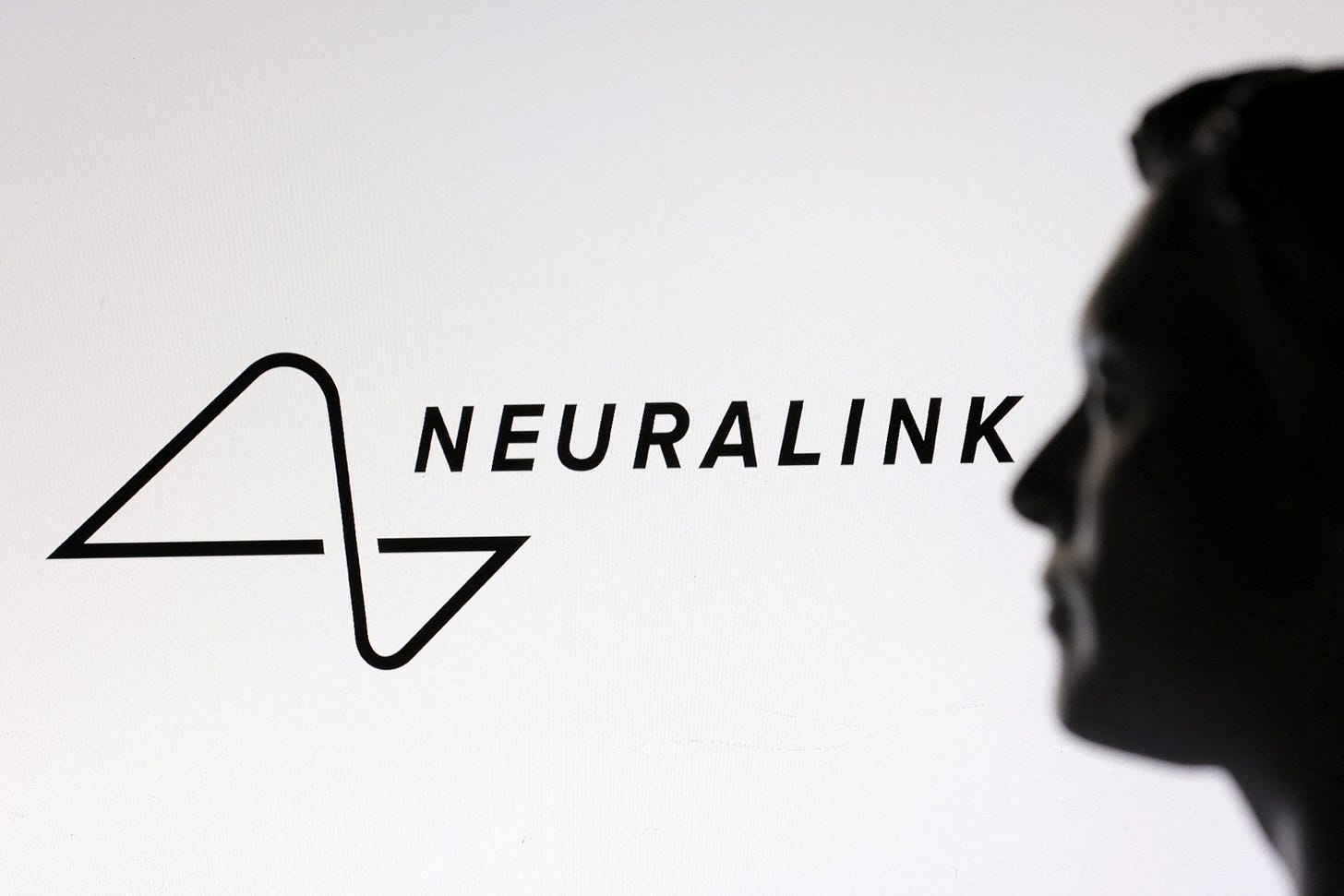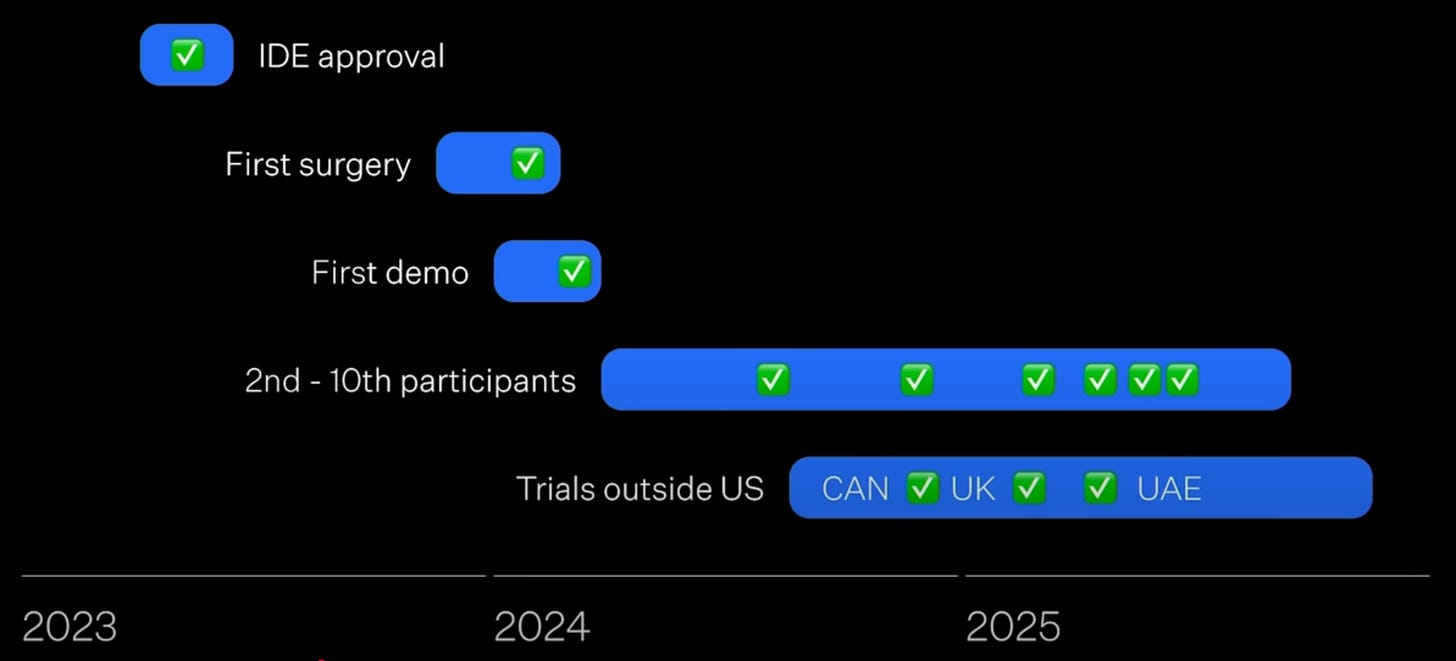Neuralink Announces 7 Total Patients Implanted with Brain-Computer Interface in Summer Update
If you want to learn more about Neuralink, check out the prior article below.
First, if you enjoy these updates, consider subscribing and becoming a part of our growing community!
Neuralink’s latest update revealed that the company’s first human clinical trial, code-named Telepathy, is well underway and expanding. The trial, which had been exclusively in the US, now counts seven participants using the Neuralink implant, and it recently secured the go-ahead to launch in Canada, the United Kingdom, and the UAE. These first users include patients with spinal cord injuries and ALS, conditions that leave them unable to move and, in some cases, even speak. In a video meet-and-greet, the “cyborg” pioneers enthusiastically shared the new freedoms this brain-computer interface (BCI) affords them – from something as basic as turning on a TV for the first time in years to returning to work and even gaming online with friends.
The real-world usage stats are impressive: participants are averaging about 50 hours per week actively using their BCI at home (not just in a lab), with some exceeding 100 hours per week – essentially using the implant every waking moment. This high engagement suggests the device is not only safe but truly practical for day-to-day life. In fact, as confidence in the device’s safety and value grew, Neuralink accelerated its implant schedule with the most recent two human surgeries just a week apart! So far, every implant is functioning well, with no serious adverse events reported. For the individuals involved, the technology is already life-changing. One trial participant, Nolan, noted he can now work, study, and even take online classes from morning until midnight – activities impossible for him before Neuralink. Another participant, Brad (who has ALS and cannot speak or move his limbs), described being able to go outside with his kids for the first time in six years, thanks to Neuralink’s “telepathic” computer control that frees him from a face-tracking tablet indoors.
These firsthand stories are very human and very powerful. They’re about people regaining some level of control and autonomy in their lives after being deprived of their most fundamental ability, that is, to control their bodies.
The theme of this update is that Neuralink implant users are regaining independence and connection in a way that is miles ahead of what they ever expected and what other technologies can provide. But it’s also about looking at what’s around the corner. It’s awe-inspiring and a startling reality that this technology is arriving.
So, what did we actually see at the Summer 2025 demo? Well, it wasn’t just anecdotes, Neuralink showed concrete technical firsts and records in brain-computer interfaces. In one striking video, Nolan (Neuralink’s first patient) achieved full cursor control on a MacBook using only his mind – no eye tracking, no muscle activity – literally by thought alone. This wasn’t a slow, lab-calibrated trick either; it was high-speed, high-precision control, and it set a new world record for BCI cursor accuracy and speed on day one. As Neuralink’s team pointed out, Nolan’s “telepathic” cursor beat what decades of prior academic research achieved, and he did it essentially immediately after activation. The presentation then leveled up the challenge to gaming. A clip of Mario Kart showed five Neuralink users racing together across the internet, each using a mind-controlled gamepad.
And another example, Neuralink demonstrated volunteers playing a first-person shooter (the video game Call of Duty) entirely via brain signals, one set of thoughts controlling the in-game character’s movement and another aiming and shooting, using different imagined motions mapped to each joystick. Controlling a modern video game typically requires several degrees of freedom plus multiple buttons, so doing it with thoughts is a massive leap. This showcases the implant’s throughput and decoding prowess; it can handle multiple simultaneous commands with enough fidelity to, beat your friends in online first-person shooters. While these demos were fun, they carried a serious implication, Neuralink’s signal quality and decoding algorithms are advancing to the point where real-time complex tasks are now possible. In the words of Neuralink engineers, the device doesn’t literally read minds, but it reads motor intentions from the brain’s electrical activity with such clarity that virtual actions feel natural.
There were a few other surprises. It turns out Neuralink’s implant isn’t limited to pixels on a screen, it’s also starting to move things out in the world. The update showcased early experiments in robotic limb control driven by Neuralink signals. One participant, Alex, had been a passionate artist with immaculate cursive handwriting until a spinal cord injury left him paralyzed from the neck down. In the presentation, Neuralink’s team handed Alex a robotic arm and, for the first time in years, he tried writing his name and drawing shapes by controlling the robot with his thoughts. This was a preliminary test (with a clamp-like gripper), but it worked, so much so that the team quickly pushed further. In the weeks leading up to the event, Neuralink achieved real-time decoding of individual finger and wrist movements from Alex’s motor cortex, allowing him to play rock-paper-scissors with his uncle via a virtual robotic hand on a screen. The ultimate goal is to bring that ability into the physical world.
In another related stunning preview, Neuralink showcased integration with Tesla’s humanoid Optimus robot platform. The event showed a clip of an Optimus robot hand replaying Alex’s exact thought-driven movements, effectively giving a glimpse of how a BCI user could control a sophisticated prosthetic hand or even an entire robot. Elon Musk took the stage to riff on the sci-fi possibilities, as Neuralink’s tech advances, a person could potentially “mentally remote into” a full-body humanoid robot, essentially using a surrogate body to move and interact in the world. If this sounds like the plot of a 2000s sci-fi thriller, it’s because it was called Surrogates starring Bruce Willis.
Musk also envisions future Neuralink integrations for those who have lost limbs – for example, attaching a robotic arm (à la Luke Skywalker’s bionic hand) that interfaces directly with the wearer’s motor cortex. Musk expressed confidence that spinal cord injuries will one day be repairable with two Neuralink units, one in the brain, one bridging the damaged section of spine, to “reanimate” paralyzed limbs and restore full body function. That’s still a long-term dream, but the early steps seen here (from mindwriting to mind-controlled rock-paper-scissors) show that brain-driven prosthetics are quickly leaving the realm of fantasy and entering reality.
So, what comes next?
While the current trial is focused on restoring mobility and computer control, Neuralink is already mapping out an ambitious whole-brain interface roadmap. This vision, as president and co-founder DJ Seo explained, means the ability to read from and write (stimulate) to any region of the brain, ultimately at high bandwidth and with 24/7 reliability. In the near term, that translates to a trio of flagship applications:
Telepathy (Motor BCI): The ongoing first product centered on high-channel output – helping people with paralysis regain digital and physical independence by controlling cursors, keyboards, and even prosthetic limbs via thoughts. This is the 1000+ channel motor implant in action today.
BlindSight (Visual Prosthesis): A high-channel input device in development to restore vision for the blind. Using a camera feed to stimulate (writing to) the visual cortex, BlindSight aims to create artificial sight. The team announced plans for their first human “Blindsight” participant in 2026, once they scale up to ~3000 electrodes and optimized stimulator hardware. Notably, Neuralink’s new “S2” chip is built ground-up for stimulation, with an impressive 1,600+ independent stim channels with finely tunable currents and voltages. They’ve also redesigned their electrode threads with larger contacts to safely deliver charge deep in the visual cortex (reaching into folded brain tissue to provide a useful field of view).
Whole-Brain Therapies: Looking further ahead, Neuralink is eyeing applications for neurological and psychiatric disorders. Imagine targeting deeper brain circuits for treating depression, anxiety, or chronic pain. The idea is to implant multiple devices across different regions (including the limbic system, which governs mood and emotion) to modulate dysfunctional neural activity. This could open the door to brain implants treating conditions currently managed (often poorly) with drugs. Musk joked that our “meat” input/output (voice, typing, etc.) is painfully slow, and that directly interfacing with more of the brain could one day enable sharing complex thoughts or emotions as effortlessly as we now share text.
To support these expansions, Neuralink is scaling up its infrastructure. The company built an advanced imaging suite with high-resolution MRI and CT scanners, creating a growing database of human brain maps to guide surgical planning. This has already paid off in more precise targeting of the motor “hand knob” area for Telepathy and is critical for safely reaching visual or speech areas. The team even developed one-click software to convert those images into automated surgical plans, feeding target coordinates to the robot for consistent thread placement.
On the surgical front, Neuralink unveiled a next-generation robotic inserter that dramatically cuts implant time. The original R1 robot took about 17 seconds per electrode thread insertion (and had to re-grab threads if disturbed). The new system (R2) brings that down to ~1.5 seconds per thread – an 11× speedup – thanks to a revamped mechanism that mounts the implant directly on the robot’s head for fast, precise deployment. It also sports an extended needle reach and depth, making the procedure anatomically compatible with >99% of patients and allowing implants up to 50-mm deep to access subcortical regions. Faster, more flexible surgery will be key as Neuralink moves from one-off surgeries to an assembly line of implants. In fact, the company stated it plans to ramp production from just a handful of devices to thousands, and eventually millions, of units per year. Achieving that will require cost breakthroughs and manufacturing innovations to drive down the overall implant cost and complexity.
Neuralink’s team often compares its progress to the computing industry’s trajectory. Just as internet bandwidth exploded from dial-up modems to fiber optic speeds, they believe BCI bandwidth, the rate of communication between brain and computer, is on the verge of a revolution. Today’s implant streams roughly a few kilobits of neural data per second; tomorrow’s will be orders of magnitude higher, unlocking finer control and sensory experiences. The roadmap laid out is bold, exciting, and scary: by next quarter they aim to begin decoding silent speech (via an implant in speech cortex), by 2026 they plan 3,000-channel devices and the first blind user with a visual prosthesis, by 2027 possibly 10,000-channel multi-implant setups connecting motor, speech, and vision areas, and by 2028, upwards of 25,000 channels per implant, with multiple implants per person to cover most of the brain’s circuitry. At that stage, the company hopes to begin exploring cognitive enhancements and direct brain-to-AI interfacing – still speculative, but not off the table if their exponential progress continues.
Neuralink’s Summer 2025 update feels like a key inflection point; they are transitioning from proof-of-concept to a potentially scalable medical technology. I find myself saying this a lot, but here it is again: I have no idea if we are ready for what will come next.
These newsletters take significant effort to put together and are totally for the reader's benefit. If you find these explorations valuable, there are multiple ways to show your support:
Engage: Like or comment on posts to join the conversation.
Subscribe: Never miss an update by subscribing to the Substack.
Share: Help spread the word by sharing posts with friends directly or on social media.
References:
https://neuralink.com/blog/a-year-of-telepathy/
https://clinicaltrials.gov/study/NCT06429735










